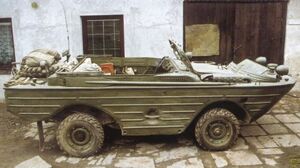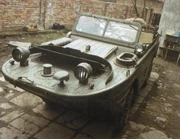 | |
| Manufacturer |
GAZ (Gorkovsky Avtomobilny Zavod or Gorky Automobile Plant) |
|---|---|
| Assembly | Russia |
| Class | 4x4 amphibious jeep |
| Body style(s) | waterproofed hull |
| Layout |
front engine, rear drive; part-time 4x4 |
| Platform | GAZ-69 |
| Engine(s) |
4 cyl petrol, 2112cc, 55 hp @ 2800 rpm, 170 nm @ 1400 rpm |
| Transmission(s) |
3-speed manual; 2-speed transfer case; water: PTO propellor drive |
| Wheelbase | 230 cm (91 inch) |
| Length | 507 cm (200 inch) |
| Width | 173,5 cm (68 inch) |
| Height | 179 cm (70 inch) |
| Curb weight | 1980 kg (GVW: 2480 kg) |
| Fuel capacity | 2 x 45 l (range 500 km) |
| Related | Ford GPA, GAZ 69 |
The GAZ-46, army designation MAV (Russian, малый автомобиль водоплавающий, small floating vehicle), is a Russian-made light four-wheel drive amphibious military vehicle, that entered service in the 1950s and has been used by many Eastern Bloc allied forces since.

GAZ 46 MAV
During the Second World War Canada, Britain and the US forwarded large quantities of military materials to Russia. Among those were jeeps, trucks, and amphibious vehicles like the 6x6 DUKW and the 4x4 Ford GPA. The latter were used to help men and equipment get across the many rivers of Eastern Europe and combat the Germans. After the war, Russia decided to develop two similar vehicles, the BAV-485, an equivalent of the DUKW, and the GAZ-46 MAV, an equivalent of the Ford GPA.
Due to bad reception of the Ford GPA 'Seep' by Allied soldiers, most of them were routed to Russia under the US Lend-Lease program, before production was halted prematurely in 1943. The Russians however badly needed jeeps with the GPA's ability to cross rivers and inland waters, so they acquired a license from Ford to start manufacturing the GPA themselves even before the war ended. After Ford had transferred all documents, tools and dies, Russian Seeps were built under license as the GAZ 011 from 1944–1945 [1].
After the war pre-production prototypes of the type GAZ-46 were built on the frame of the GAZ-67B 4x4 in production during the war. Series production GAZ-46 vehicles were based on the post-war GAZ-69 4x4 half-ton light truck, of which production started with the Gorki factory of 1952. The principal functions of the GAZ-46 MAV were to make light work of crossing lakes and rivers for men and materials, as well as performing river reconnaissance. As of the end of the fifties the latter role became reserved for the BRDM-1, a much more powerful 4x4 amphibious vehicle.
Although the GAZ-46 MAV used the mechanics of existing Russian GAZ 4x4 "jeeps" as well as being created somewhat bigger for better buoyancy, its design is heavily inspired by that of the wartime Ford GPA. Just like the 'Seep', its hull is entirely out of steel, welded to a steel chassis. The layout is the same: engine compartment in the front, crew compartment in the center, and the spare wheel horizontally mounted on the rear deck. The driver and the commander of the vehicle have individual seats in the front with a three seat bench behind them. The windshield can be folded down, and if necessary, a cover can be installed to close the cockpit. The engine is coupled to a manual three-speed gearbox and a two-speed transfer-case. Also there is a screw-propellor for in the water propulsion, driven by a power take-off, and a proper rudder provides good maneuverability. Front and rear suspension is in the form of leaf-sprung rigid live axles. Thanks to its steeply raked front and rear and four-wheel drive, the GAZ can manage reasonably steep river banks before swimming across.
Literature[]
- René Pohl: Mit dem Auto baden gehen. HEEL Verlag, Gut-Pottscheidt Konigswinter 1998, ISBN 3-89365-702-9
See also[]
References[]
| This page uses some content from Wikipedia. The original article was at GAZ 46. The list of authors can be seen in the page history. As with Tractor & Construction Plant Wiki, the text of Wikipedia is available under the Creative Commons by Attribution License and/or GNU Free Documentation License. Please check page history for when the original article was copied to Wikia |